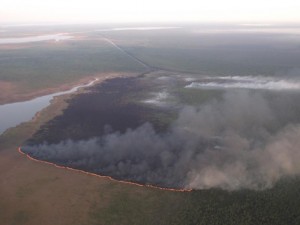
In Beaufort, the first sign that something was amiss occurred on Sunday night. The air became thick with haze and smelled like of burning mulch. At first we thought it was just an overzealous barbecue somewhere down the road, but as we drove over the Morehead City highrise bridge, we discovered that the smoke was everywhere. This wasn’t an isolated grilling accident, trash burn, or house on fire, some thing was burning, something big. It could only be a forest fire, and, judging by the direction of the wind, it was blowing in from somewhere near the Outer Banks.
It started small. A lightning strike on May 5 ignited a patch of wetlands in the Alligator River National Wildlife Refuge in Dare Country, NC. As it grew, it crossed Highway 264, forcing road closures. By Monday, it had consumed more the 20,950 acres of forest. Although no injuries or property damage has been reported, it is approaching Stumpy Point, a small coastal Carolina town with a population of about 1,000. This ecosystem is also home to the endangered red-cockaded woodpecker and the only place where you can still find wild Red Wolves. It is home to the Red Wolf Recovery Program.
More troubling was the news this morning that the fire had spread to the Dare County Bombing Range, a practice site used by pilots out of the Seymour Johnson Airforce Base and Oceana Naval Air Station. Unexploded ordinance in the range will make it difficult for firefighters to control the blaze. Fortunately, several fire suppression measure have been in place since at least the early-seventies to control fires that start within the bomb range.
If the news from North Carolina seems reminiscent of past stories from the West, it is because the forests from both coasts share a similar ecology – one dominated by fires. Naturally, these fires are started by lightning and burn at a moderate temperatures through the understory. This clears out any shrubs, dead trees, and other natural fuel. The dominant conifers and herbaceous plants depend on the smoke and heat to germinate the next generation’s seeds, while the adult trees remain standing, cleaned of their shrubby competition. In the pine marshes of the Alligator National Wildlife Refuge where this fire ignited, this type of fire occurs roughly ever 100 years.
This is not the first time Dare County has faced a large wildfire. The Air Force Bomb Range Fire of 1971, which consumed almost 30,000 acres, is one of the most well studied forest fires on the eastern seaboard. The largest recorded fire occurred in 1955, when more than 250,000 acres burned. Fires in this region are particularly difficult to control because the dense pocosin understory which provides plenty of fuel during dry seasons and impedes the progress of fire fighting teams.
Modern wildfires are often either human-caused or human-perpetuated. The latter of these concerns comes from fire suppression and wetland draining. There’s a long and complicated history of wildfire suppression in the United States, exemplified by the image of Smokey the Bear. Created as the face of a campaign that painted fires as devastating no matter what context, American forests faced a century of aggressive fire suppression that allowed “unnatural fuel buildup” (Brown 1983) in forest understories. When lightning does strike, the fire that results burns much hotter and taller than the natural fires, fueled by extra shrubs, dead wood, and layers of leaves.
Taller, hotter fires can ignite parent trees resulting in a crown fire that wipes out the foundation community; forest succession must begin anew. Crown fires spread much easier and can jump fire breaks. Fortunately, the fire currently burning here in North Carolina started on Fish and Wildlife land that is managed with prescribed burns. Impacts to wildlife and ecological processes are expected to be minimal. Unfortunately, the region has been extensively drained and mined for peat, drastically changing the wetland hydrology that plays a large role in fire suppression. Combined with low atmospheric humidity, the artifically dry peatlands perpetuate fires in the area. As a result, it is the peat that continues to burn.
Although this fire was started naturally, many forest fires start prematurely. In a study of US Forest Service lands from 1940 – 2000, the number of human ignitions increased, resulting in an overall increased in burnt lands (Stephens 2005). In fact, in California arson was a more common cause of ignition than lightning and in the Northern Rockies, more than 50% of fires are human-caused. Many of the human causes are from escaped campfires, cigarettes, fireworks, and trash burning. These are normal activities that turn risky come hot, dry summers, especially as human population increasingly encroaches into wilderness areas with a natural fire regime.
Wade, Dale D., & Ward, Darold E. (1973). An Analysis of the Air Force Bomb Range Fire USDA Forest Service Research Paper, 1-38
Brown JK (1983) The “unnatural fuel buildup” issue. Pages 127–128 in Proceedings of a symposium and workshop on wilderness fire. General technical report INT-182. U.S. Forest Service, Ogden, Utah.
Stephens SL (2005) Forest fire causes and extent on United States Forest Service lands. International Journal of Wildland Fire 14, 213–222.
doi:10.1071/WF04006
We were in Nag’s Head that weekend (6th/7th), and the ash was falling at least that far up the OBX. They are doing controlled burns of underbrush near Stumpy Point in hopes of keeping it from crossing the highway.
http://www2.nbc17.com/news/2011/jun/05/brush-fire-operation-termed-successful-us-264-stil-ar-1094344/